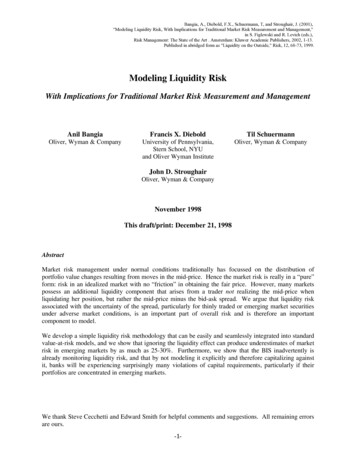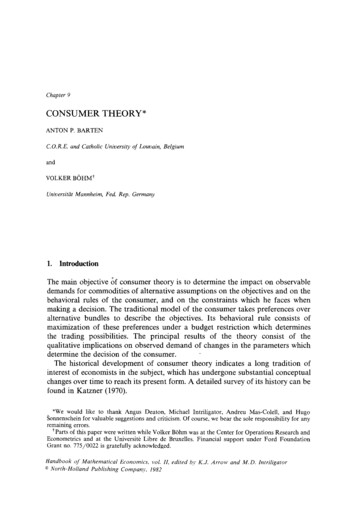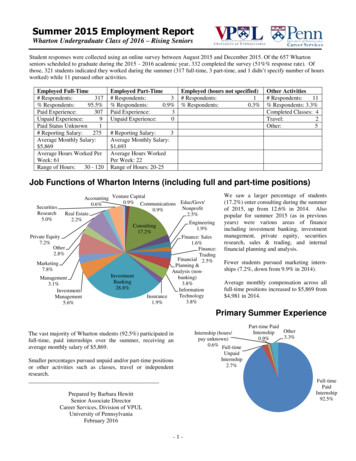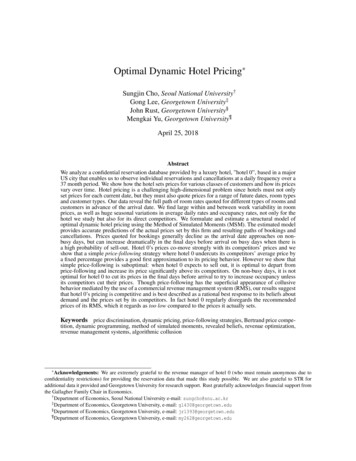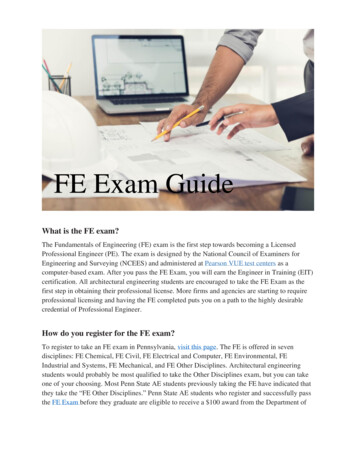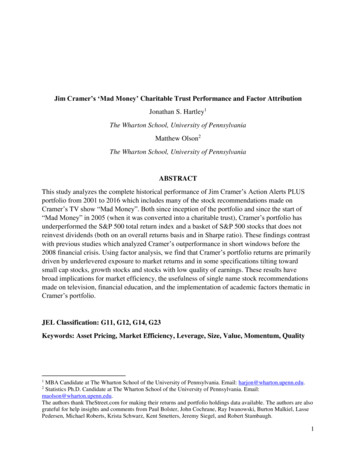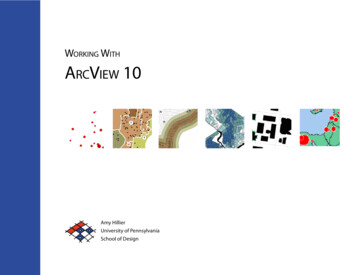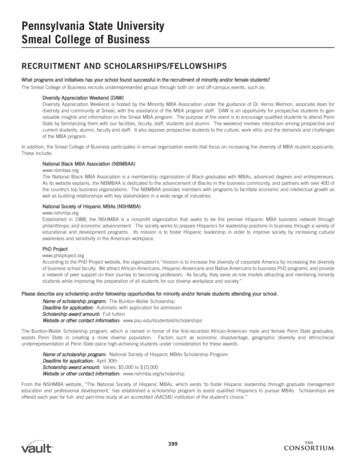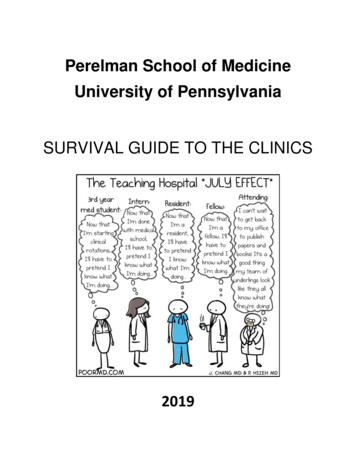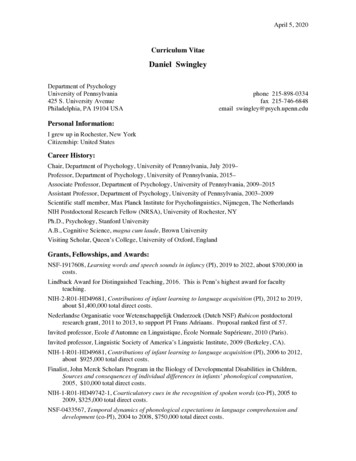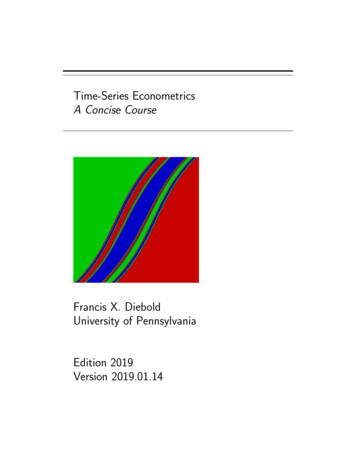
Transcription
Time-Series EconometricsA Concise CourseFrancis X. DieboldUniversity of PennsylvaniaEdition 2019Version 2019.01.14
Time Series Econometrics
Time Series EconometricsA Concise CourseFrancis X. Diebold
Copyright c 2013-2019, by Francis X. Diebold.All rights reserved.This work is freely available for your use, but be warned: it is highly preliminary, significantlyincomplete, and rapidly evolving. It is licensed under the Creative Commons AttributionNonCommercial-NoDerivatives 4.0 International License. (Briefly: I retain copyright, butyou can use, copy and distribute non-commercially, so long as you give me attribution and donot modify. To view a copy of the license, visit http://creativecommons.org/licenses/by-ncnd/4.0/.) In return I ask that you please cite the book whenever appropriate, as: “Diebold,F.X. (2019), Time Series Econometrics, Department of Economics, University of Pennsylvania, http://www.ssc.upenn.edu/ fdiebold/Textbooks.html.”
To Marc Nerlove,who taught me time series,and to my wonderful Ph.D. students,his “grandstudents”
Brief Table of ContentsAbout the AuthorxvAbout the CoverxviGuide to er 1.The Wold Representation and its Approximation1Chapter 2.Spectral Analysis23Chapter 3.Markovian Structure, Linear Gaussian State Space, and Optimal (Kalman) Filtering47Chapter 4.Frequentist Time-Series Likelihood Evaluation, Optimization, and Inference79Chapter 5.Simulation Basics90Chapter 6.Bayesian Analysis by Simulation96Chapter 7.(Much) More Simulation109Chapter 8.Non-Stationarity: Integration, Cointegration and Long Memory126Chapter 9.Non-Linear Non-Gaussian State Space and Optimal Filtering138Chapter 10. Volatility Dynamics145Chapter 11. High Dimensionality186Appendices187Appendix A. A “Library” of Useful Books188
Detailed Table of ContentsAbout the AuthorxvAbout the CoverxviGuide to er 1.1.11.21.31.41.51.61.71.81.91.10Economic Time Series and Their AnalysisThe EnvironmentWhite NoiseThe Wold Decomposition and the General Linear ProcessApproximating the Wold Representation1.5.1 The M A(q) Process1.5.2 The AR(p) Process1.5.3 The ARM A(p, q) ProcessWiener-Kolmogorov-Wold Extraction and Prediction1.6.1 Extraction1.6.2 PredictionMultivariate1.7.1 The Environment1.7.2 The Multivariate General Linear Process1.7.3 Vector AutoregressionsExercises, Problems and ComplementsNotesExercises, Problems and ComplementsChapter 2.2.12.22.32.42.52.62.72.82.9The Wold Representation and its ApproximationSpectral AnalysisThe Many Uses of Spectral AnalysisThe Spectrum and its PropertiesRational SpectraMultivariateFilter Analysis and DesignEstimating Spectra2.6.1 Univariate2.6.2 MultivariateApproximate (asymptotic) frequency domain Gaussian likelihoodExercises, Problems and 343436363746
xiiDETAILED TABLE OF CONTENTSChapter 3.3.13.23.33.43.5Chapter 355606263646566696970727278Frequentist Time-Series Likelihood Evaluation, Optimization, and Inference79Likelihood Evaluation: Prediction-Error Decomposition and the Kalman FilterGradient-Based Likelihood Maximization: Newton and Quasi-Newton Methods4.2.1 The Generic Gradient-Based Algorithm4.2.2 Newton Algorithm4.2.3 Quasi-Newton Algirithms4.2.4 “Line-Search” vs. “Trust Region” Methods: Levenberg-MarquardtGradient-Free Likelihood Maximization: EM4.3.1 “Not-Quite-Right EM”(But it Captures and Conveys the Intuition)4.3.2 Precisely Right EMLikelihood Inference4.4.1 Under Correct Specification4.4.2 Under Possible MispecificationExercises, Problems and ComplementsNotes79808081828283Chapter 5.5.15.2Markovian Structure, Linear Gaussian State Space, and Optimal (Kalman) FilteringMarkovian Structure3.1.1 The Homogeneous Discrete-State Discrete-Time Markov Process3.1.2 Multi-Step Transitions: Chapman-Kolmogorov3.1.3 Lots of Definitions (and a Key Theorem)3.1.4 A Simple Two-State Example3.1.5 Constructing Markov Processes with Useful Steady-State Distributions3.1.6 Variations and Extensions: Regime-Switching and More3.1.7 Continuous-State Markov ProcessesState Space Representations3.2.1 The Basic Framework3.2.2 ARMA Models3.2.3 Linear Regression with Time-Varying Parameters and More3.2.4 Dynamic Factor Models3.2.5 Unobserved-Components ModelsThe Kalman Filter and Smoother3.3.1 Statement(s) of the Kalman Filter3.3.2 Derivation of the Kalman Filter3.3.3 Calculating P03.3.4 Predicting yt3.3.5 Steady State and the Innovations Representation3.3.6 Kalman SmoothingExercises, Problems and ComplementsNotesSimulation BasicsGenerating U(0,1) DeviatesThe Basics: c.d.f. Inversion, Box-Mueller, Simple Accept-Reject5.2.1 Inverse c.d.f.5.2.2 Box-Muller5.2.3 Simple Accept-RejectSimulating Exact and Approximate Realizations of Time Series ProcessesmoreNotesChapter 6.Bayesian Analysis by Simulation8484868687898990909191929394959596
DETAILED TABLE OF CONTENTS6.16.26.36.46.56.66.76.8Bayesian BasicsComparative Aspects of Bayesian and Frequentist ParadigmsMarkov Chain Monte Carlo6.3.1 Metropolis-Hastings Independence Chain6.3.2 Metropolis-Hastings Random Walk Chain6.3.3 More6.3.4 Gibbs and Metropolis-Within-GibbsConjugate Bayesian Analysis of Linear RegressionGibbs for Sampling Marginal PosteriorsGeneral State Space: Carter-Kohn Multi-Move GibbsExercises, Problems and ComplementsNotesChapter 7.7.17.27.37.47.57.67.77.8Economic Theory by Simulation: “Calibration”Econometric Theory by Simulation: Monte Carlo and Variance Reduction7.2.1 Experimental Design7.2.2 Simulation7.2.3 Variance Reduction: Importance Sampling, Antithetics, Control Variatesand Common Random Numbers7.2.4 Response SurfacesEstimation by Simulation: GMM, SMM and Indirect Inference7.3.1 GMM7.3.2 Simulated Method of Moments (SMM)7.3.3 Indirect InferenceInference by Simulation: Bootstrap7.4.1 i.i.d. Environments7.4.2 Time-Series EnvironmentsOptimization by Simulation7.5.1 Local7.5.2 Global7.5.3 Is a Local Optimum Global?Interval and Density Forecasting by SimulationExercises, Problems and ComplementsNotesChapter 8.8.18.28.38.48.58.68.78.88.9Non-Stationarity: Integration, Cointegration and Long MemoryRandom Walks as the I(1) Building Block: The Beveridge-Nelson DecompositionStochastic vs. Deterministic TrendUnit Root DistributionsUnivariate and Multivariate Augmented Dickey-Fuller RepresentationsSpurious RegressionCointegration, Error-Correction and Granger’s Representation TheoremFractional Integration and Long MemoryExercises, Problems and ComplementsNotesChapter 9.9.19.29.39.49.5(Much) More SimulationNon-Linear Non-Gaussian State Space and Optimal FilteringVarieties of Non-Linear Non-Gaussian ModelsMarkov Chains to the Rescue (Again): The Particle FilterParticle Filtering for Estimation: Doucet’s TheoremKey Application I: Stochastic Volatility (Revisited)Key Application II: Credit-Risk and the Default 8
xiv9.69.7DETAILED TABLE OF CONTENTSKey Application III: Dynamic Stochastic General Equilibrium (DSGE) Macroeconomic ModelsA Partial “Solution”: The Extended Kalman FilterChapter 10. Volatility Dynamics10.110.210.310.410.510.6Volatility and Financial EconometricsGARCHStochastic VolatilityObservation-Driven vs. Parameter-Driven ProcessesExercises, Problems and ComplementsNotesChapter 11. High Dimensionality11.111.2Exercises, Problems and 86Appendices187Appendix A. A “Library” of Useful Books188
About the AuthorFrancis X. Diebold is Paul F. and Warren S. Miller Professor of Economics, and Professorof Finance and Statistics, at the University of Pennsylvania, as well as Faculty Research Associate at the National Bureau of Economic Research in Cambridge, Mass. He has publishedwidely in econometrics, forecasting, finance and macroeconomics, and he has served on theeditorial boards of numerous scholarly journals. He is an elected Fellow of the EconometricSociety, the American Statistical Association, and the International Institute of Forecasters;the recipient of Sloan, Guggenheim, and Humboldt fellowships; and past President of theSociety for Financial Econometrics. Diebold lectures actively, worldwide, and has receivedseveral prizes for outstanding teaching. He has held visiting appointments in Economics andFinance at Princeton University, Cambridge University, the University of Chicago, the London School of Economics, Johns Hopkins University, and New York University. His researchand teaching are firmly rooted in applications; he has served as an economist under PaulVolcker and Alan Greenspan at the Board of Governors of the Federal Reserve System inWashington DC, an Executive Director at Morgan Stanley Investment Management, CoDirector of the Wharton Financial Institutions Center, and Chairman of the Federal ReserveSystem’s Model Validation Council. All his degrees are from the University of Pennsylvania;he received his B.S. from the Wharton School in 1981 and his economics Ph.D. in in 1986.He is married with three children and lives in suburban Philadelphia.
About the CoverThe colorful graphic is by Peter Mills and was obtained from Wikimedia Commons. Asnoted there, it represents “the basins of attraction of the Gaspard-Rice scattering systemprojected onto a double impact parameter” (whatever that means). I used it mainly becauseI like it, but also because it’s reminiscent of a trending time series.For details see http://commons.wikimedia.org/wiki/File%3AGR Basins2.tiff. Thecomplete attribution is: By Peter Mills (Own work) [CC-BY-SA-3.0 (http://creativecommons.org/licenses/by-sa/3.0)], via Wikimedia Commons)
Guide to e-Features Hyperlinks to internal items (table of contents, index, footnotes, etc.) appear in red. Hyperlinks to bibliographic references appear in green. Hyperlinks to the web appear in cyan. Hyperlinks to external files (e.g., video) appear in blue. Many images are clickable to reach related material. Additional related materials are at http://www.ssc.upenn.edu/ fdiebold, including book updates, presentation slides, datasets, and code. Facebook group: Diebold Time Series Econometrics Related blog (No Hesitations): fxdiebold.blogspot.com
AcknowledgmentsAll media (images, audio, video, .) were either produced by me or obtained from thepublic domain repository at Wikimedia Commons.
List of Figures1.11.2The R HomepageResources for Economists Web Page16172.12.22.32.42.5Granger’s Typical Spectral Shape of an Economic VariableGain of Differencing Filter 1 LGain of Kuznets’ Filter 1Gain of Kuznets’ Filter 2Composite Gain of Kuznets’ two Filters27313232335.1Ripley’s “Horror” Plots of pairs of (Ui 1 , Ui ) for Various CongruentialGenerators Modulo 2048 (from Ripley, 1987)Transforming from U(0,1) to f (from Davidson and MacKinnon, 1993)Naive Accept-Reject Method9192945.25.310.110.210.310.410.510.6Time Series of Daily NYSE ReturnsCorrelogram of Daily NYSE Returns.Histogram and Statistics for Daily NYSE Returns.Time Series of Daily Squared NYSE Returns.Correlogram of Daily Squared NYSE Returns.True Exceedance Probabilities of Nominal 1% HS-V aR When Volatilityis Persistent. We simulate returns from a realistically-calibrated dynamic volatility146147147148148model, after which we compute 1-day 1% HS-V aR using a rolling window of 500 observations. We plot the daily series of true conditional exceedance probabilities, whichwe infer from the model. For visual reference we include a horizontal line at the desired1% probability level.10.7 GARCH(1,1) Estimation, Daily NYSE Returns.10.8 Correlogram of Squared Standardized GARCH(1,1) Residuals, Daily NYSEReturns.10.9 Estimated Conditional Standard Deviation, Daily NYSE Returns.10.10Conditional Standard Deviation, History and Forecast, Daily NYSE Returns.10.11AR(1) Returns with Threshold t-GARCH(1,1)-in Mean.10.12S&P500 Daily Returns and Volatilities (Percent). The top panel shows daily151157158158158159S&P500 returns, and the bottom panel shows daily S&P500 realized volatility. Wecompute realized volatility as the square root of AvgRV , where AvgRV is the averageof five daily RVs each computed from 5-minute squared returns on a 1-minute grid ofS&P500 futures prices.160
xxLIST OF FIGURES10.13S&P500: QQ Plots for Realized Volatility and Log Realized Volatility.The top panel plots the quantiles of daily realized volatility against the correspondingnormal quantiles. The bottom panel plots the quantiles of the natural logarithm of dailyrealized volatility against the corresponding normal quantiles. We compute realizedvolatility as the square root of AvgRV , where AvgRV is the average of five daily RVseach computed from 5-minute squared returns on a 1-minute grid of S&P500 futuresprices.16110.14S&P500: Sample Autocorrelations of Daily Realized Variance and DailyReturn. The top panel shows realized variance autocorrelations, and the bottom panelshows return autocorrelations, for displacements from 1 through 250 days. Horizontallines denote 95% Bartlett bands. Realized variance is AvgRV , the average of five dailyRVs each computed from 5-minute squared returns on a 1-minute grid of S&P500futures prices.10.15Time-Varying International Equity Correlations. The figure shows the estimated equicorrelations from a DECO model for the aggregate equity index returns for16 different developed markets from 1973 through 2009.10.16QQ Plot of S&P500 Returns. We show quantiles of daily S&P500 returns fromJanuary 2, 1990 to December 31, 2010, against the corresponding quantiles from astandard normal distribution.10.17QQ Plot of S&P500 Returns Standardized by NGARCH Volatilities. Weshow quantiles of daily S&P500 returns standardized by the dynamic volatility from aNGARCH model against the corresponding quantiles of a standard normal distribution.The sample period is January 2, 19
10.4 Time Series of Daily Squared NYSE Returns.148 10.5 Correlogram of Daily Squared NYSE Returns.148 10.6 True Exceedance Probabilities of Nominal 1% HS-VaRWhen Volatility is Persistent. We simulate returns from a realistically-calibrated dynamic volatility model, after which we compute 1-day 1% HS-VaRusing a rolling window of 500 ob- servations. We plot the daily series of true conditional .
